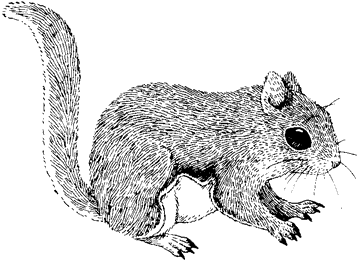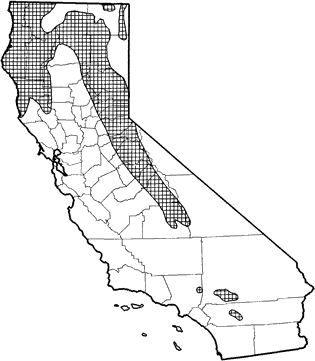
Northern Flying Squirrel
Distribution, Abundance, and Seasonality
Locally common, yearlong resident of coniferous habitats from ponderosa pine through lodgepole pine forests (1500-2450 m; 5000-8000 ft) and riparian-deciduous forests of the North Coast, Klamath, Cascade, Sierra Nevada Ranges, and the Warner Mts.

Range Map
Specific Habitat Requirements
Feeding: Northern flying squirrels are omnivorous. They eat seeds, nuts, and fruits of conifers, oaks, other trees, and shrubs. They also eat lichens, fungi, arthropods, eggs, and birds (Bailey 1936, Jackson 1961). In northeastern California, the diet was entirely lichens (Alectoria fremontii or Usnea ceratina), fungi, and various small animals (McKeever 1960). Forage in trees and on the forest floor. Also may bury seeds in ground, or store food in crevices.
Cover: Flying squirrels use cavities in mature trees, snags, or logs for cover.
Reproduction: Most nests are in cavities in trees or snags. Some nests are constructed on tree branches using twigs and leaves; occasionally a bird's nest is remodelled. Nests are lined with bark, leaves, lichens, or twigs (Wells-Gosling and Heaney 1984).
Water: These tree squirrels live near rivers and streams, and probably require drinking water, at least in summer.
Pattern: Mature, dense conifer habitats intermixed with various riparian habitats support flying squirrel populations. Large trees and snags required.
Species Life History
Activity Patterns: Yearlong nocturnal activity. Somewhat gregarious in winter.
Seasonal Movements / Migration: Non-migratory.
Home Range: In the Sierra Nevada, home range of a mother-young group was 2 ha (5 ac) (MacClintock 1970). In North Carolina and Pennsylvania, home ranges of southern flying squirrels averaged 7.4 ha (18.3 ac), and varied from 5-13 ha (12-31 ac) (Weigl and Osgood 1974).
Territory: No data found.
Reproduction: Apparently often mate in March. Following a gestation of 37-40 days (Muul 1969), an average of 4 young born (range 1-6) and cared for by the female. Young are weaned at about 80 days (Muul 1969). Usually 1 litter per yr, but 2 litters may be common in the southern part of the range. Males and females are sexually mature within the first yr.
Niche: Clearcutting and loss of snags probably have contributed to a decline in numbers. Large owls, especially spotted owls, catch flying squirrels as they glide from tree to tree (Ingles 1965). Also preyed upon by domestic cats, martens, fishers, bobcats, and long tailed weasels (Maser et al. 1981).
Sources & References
California Department of Fish and Game, 1999.
California's Wildlife, Sacramento, CA.
Written by: T. Harvey, C. Polite, reviewed by: M. White, edited by: M. White
Bailey, V. 1936. The mammals and life zones of Oregon. U.S. Dep. Agric., North Am. Fauna No. 55. 416pp. Ingles, L. G. 1965. Mammals of the Pacific states. Stanford Univ. Press, Stanford, CA. 506pp. Jackson, H. H. T. 1961. Mammals of Wisconsin. Univ. Wisconsin Press, Madison. 504pp. MacClintock, D. 1970. Squirrels of North America. Van Nostrand Reinhold, New York. 184pp. Maser, C., B. R. Mate, J. F. Franklin, and C. T. Dyrness. 1981. Natural history of Oregon coast mammals. Pac. Northwest For. And Range Exp. Sta., USDA, For. Serv., Gen. Tech. Rep., PNW-133. 496pp. McKeever, S. 1960. Food of the northern flying squirrel in northeastern California. J. Mammal. 41:270-271. Muul, I. 1969. Mating behavior, gestation period, and development of Glaucomys sabrinus. J. Mammal. 50:121. Storer, T. I., and R. L. Usinger. 1963. Sierra Nevada natural history. Univ. California Press, Berkeley. 374pp. Weigl, P. D., and D. W. Osgood. 1974. Study of the northern flying squirrel, Glaucomys sabrinus, by temperature telemetry. Amer. Midl. Nat. 92:482-486. Wells-Gosling. N., and L. R. Heaney. 1984. Glaucomys sabrinus. Mammal. Species No. 229. 8pp.
California Animal Facts | California's Wildlife